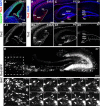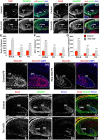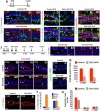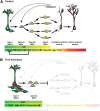Tbr2 is essential for hippocampal lineage progression from neural stem cells to intermediate progenitors and neurons
- PMID: 22553033
- PMCID: PMC3366485
- DOI: 10.1523/JNEUROSCI.0532-12.2012
Tbr2 is essential for hippocampal lineage progression from neural stem cells to intermediate progenitors and neurons
Abstract
Neurogenesis in the dentate gyrus has been implicated in cognitive functions, including learning and memory, and may be abnormal in major neuropsychiatric disorders, such as depression. Dentate neurogenesis is regulated by interactions between extrinsic factors and intrinsic transcriptional cascades that are currently not well understood. Here we show that Tbr2 (also known as Eomes), a T-box transcription factor expressed by intermediate neuronal progenitors (INPs), is critically required for neurogenesis in the dentate gyrus of developing and adult mice. In the absence of Tbr2, INPs are depleted despite augmented neural stem cell (NSC) proliferation, and neurogenesis is halted as the result of failed neuronal differentiation. Interestingly, we find that Tbr2 likely promotes lineage progression from NSC to neuronal-specified INP in part by repression of Sox2, a key determinant of NSC identity. These findings suggest that Tbr2 expression in INPs is critical for neuronal differentiation in the dentate gyrus and that INPs are an essential stage in the lineage from NSCs to new granule neurons in the dentate gyrus.
Figures







Similar articles
-
Tbr2 expression in Cajal-Retzius cells and intermediate neuronal progenitors is required for morphogenesis of the dentate gyrus.J Neurosci. 2013 Feb 27;33(9):4165-80. doi: 10.1523/JNEUROSCI.4185-12.2013. J Neurosci. 2013. PMID: 23447624 Free PMC article.
-
Brain Insulin-Like Growth Factor-I Directs the Transition from Stem Cells to Mature Neurons During Postnatal/Adult Hippocampal Neurogenesis.Stem Cells. 2016 Aug;34(8):2194-209. doi: 10.1002/stem.2397. Epub 2016 May 27. Stem Cells. 2016. PMID: 27144663
-
Intermediate progenitors in adult hippocampal neurogenesis: Tbr2 expression and coordinate regulation of neuronal output.J Neurosci. 2008 Apr 2;28(14):3707-17. doi: 10.1523/JNEUROSCI.4280-07.2008. J Neurosci. 2008. PMID: 18385329 Free PMC article.
-
Control of Neuronal Development by T-Box Genes in the Brain.Curr Top Dev Biol. 2017;122:279-312. doi: 10.1016/bs.ctdb.2016.08.001. Epub 2016 Sep 1. Curr Top Dev Biol. 2017. PMID: 28057268 Review.
-
Adult neurogenesis in the mammalian dentate gyrus.Anat Histol Embryol. 2020 Jan;49(1):3-16. doi: 10.1111/ahe.12496. Epub 2019 Sep 30. Anat Histol Embryol. 2020. PMID: 31568602 Review.
Cited by
-
Neurogenesis From Embryo to Adult - Lessons From Flies and Mice.Front Cell Dev Biol. 2020 Jun 30;8:533. doi: 10.3389/fcell.2020.00533. eCollection 2020. Front Cell Dev Biol. 2020. PMID: 32695783 Free PMC article. Review.
-
Dentate Gyrus Development Requires ERK Activity to Maintain Progenitor Population and MAPK Pathway Feedback Regulation.J Neurosci. 2015 Apr 29;35(17):6836-48. doi: 10.1523/JNEUROSCI.4196-14.2015. J Neurosci. 2015. PMID: 25926459 Free PMC article.
-
Identification of a sustained neurogenic zone at the dorsal surface of the adult mouse hippocampus and its regulation by the chemokine SDF-1.Hippocampus. 2015 Nov;25(11):1224-41. doi: 10.1002/hipo.22428. Epub 2015 Mar 27. Hippocampus. 2015. PMID: 25656357 Free PMC article.
-
Chronic chemogenetic activation of hippocampal progenitors enhances adult neurogenesis and modulates anxiety-like behavior and fear extinction learning.IBRO Neurosci Rep. 2024 Jan 22;16:168-181. doi: 10.1016/j.ibneur.2024.01.002. eCollection 2024 Jun. IBRO Neurosci Rep. 2024. PMID: 39007086 Free PMC article.
-
Cell-Biological Requirements for the Generation of Dentate Gyrus Granule Neurons.Front Cell Neurosci. 2018 Nov 12;12:402. doi: 10.3389/fncel.2018.00402. eCollection 2018. Front Cell Neurosci. 2018. PMID: 30483057 Free PMC article. Review.
References
Publication types
MeSH terms
Substances
Grants and funding
LinkOut - more resources
Full Text Sources
Medical
Molecular Biology Databases
